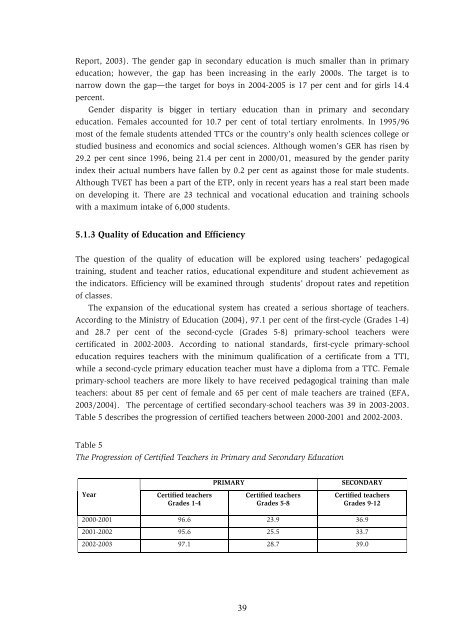Education and Training in Ethiopia An Evaluation of Approaching EFA Goals
Education and Training in Ethiopia - Koulutuksen tutkimuslaitos
Education and Training in Ethiopia - Koulutuksen tutkimuslaitos
- No tags were found...
Create successful ePaper yourself
Turn your PDF publications into a flip-book with our unique Google optimized e-Paper software.
Report, 2003). The gender gap <strong>in</strong> secondary education is much smaller than <strong>in</strong> primaryeducation; however, the gap has been <strong>in</strong>creas<strong>in</strong>g <strong>in</strong> the early 2000s. The target is tonarrow down the gap—the target for boys <strong>in</strong> 2004-2005 is 17 per cent <strong>and</strong> for girls 14.4percent.Gender disparity is bigger <strong>in</strong> tertiary education than <strong>in</strong> primary <strong>and</strong> secondaryeducation. Females accounted for 10.7 per cent <strong>of</strong> total tertiary enrolments. In 1995/96most <strong>of</strong> the female students attended TTCs or the country’s only health sciences college orstudied bus<strong>in</strong>ess <strong>and</strong> economics <strong>and</strong> social sciences. Although women’s GER has risen by29.2 per cent s<strong>in</strong>ce 1996, be<strong>in</strong>g 21.4 per cent <strong>in</strong> 2000/01, measured by the gender parity<strong>in</strong>dex their actual numbers have fallen by 0.2 per cent as aga<strong>in</strong>st those for male students.Although TVET has been a part <strong>of</strong> the ETP, only <strong>in</strong> recent years has a real start been madeon develop<strong>in</strong>g it. There are 23 technical <strong>and</strong> vocational education <strong>and</strong> tra<strong>in</strong><strong>in</strong>g schoolswith a maximum <strong>in</strong>take <strong>of</strong> 6,000 students.5.1.3 Quality <strong>of</strong> <strong>Education</strong> <strong>and</strong> EfficiencyThe question <strong>of</strong> the quality <strong>of</strong> education will be explored us<strong>in</strong>g teachers’ pedagogicaltra<strong>in</strong><strong>in</strong>g, student <strong>and</strong> teacher ratios, educational expenditure <strong>and</strong> student achievement asthe <strong>in</strong>dicators. Efficiency will be exam<strong>in</strong>ed through students’ dropout rates <strong>and</strong> repetition<strong>of</strong> classes.The expansion <strong>of</strong> the educational system has created a serious shortage <strong>of</strong> teachers.Accord<strong>in</strong>g to the M<strong>in</strong>istry <strong>of</strong> <strong>Education</strong> (2004), 97.1 per cent <strong>of</strong> the first-cycle (Grades 1-4)<strong>and</strong> 28.7 per cent <strong>of</strong> the second-cycle (Grades 5-8) primary-school teachers werecertificated <strong>in</strong> 2002-2003. Accord<strong>in</strong>g to national st<strong>and</strong>ards, first-cycle primary-schooleducation requires teachers with the m<strong>in</strong>imum qualification <strong>of</strong> a certificate from a TTI,while a second-cycle primary education teacher must have a diploma from a TTC. Femaleprimary-school teachers are more likely to have received pedagogical tra<strong>in</strong><strong>in</strong>g than maleteachers: about 85 per cent <strong>of</strong> female <strong>and</strong> 65 per cent <strong>of</strong> male teachers are tra<strong>in</strong>ed (<strong>EFA</strong>,2003/2004). The percentage <strong>of</strong> certified secondary-school teachers was 39 <strong>in</strong> 2003-2003.Table 5 describes the progression <strong>of</strong> certified teachers between 2000-2001 <strong>and</strong> 2002-2003.Table 5The Progression <strong>of</strong> Certified Teachers <strong>in</strong> Primary <strong>and</strong> Secondary <strong>Education</strong>PRIMARYSECONDARYYearCertified teachersGrades 1-4Certified teachersGrades 5-8Certified teachersGrades 9-122000-2001 96.6 23.9 36.92001-2002 95.6 25.5 33.72002-2003 97.1 28.7 39.039




![to read the full report [pdf, Amharic] - Ethiopian Review](https://img.yumpu.com/52737829/1/190x245/to-read-the-full-report-pdf-amharic-ethiopian-review.jpg?quality=85)











